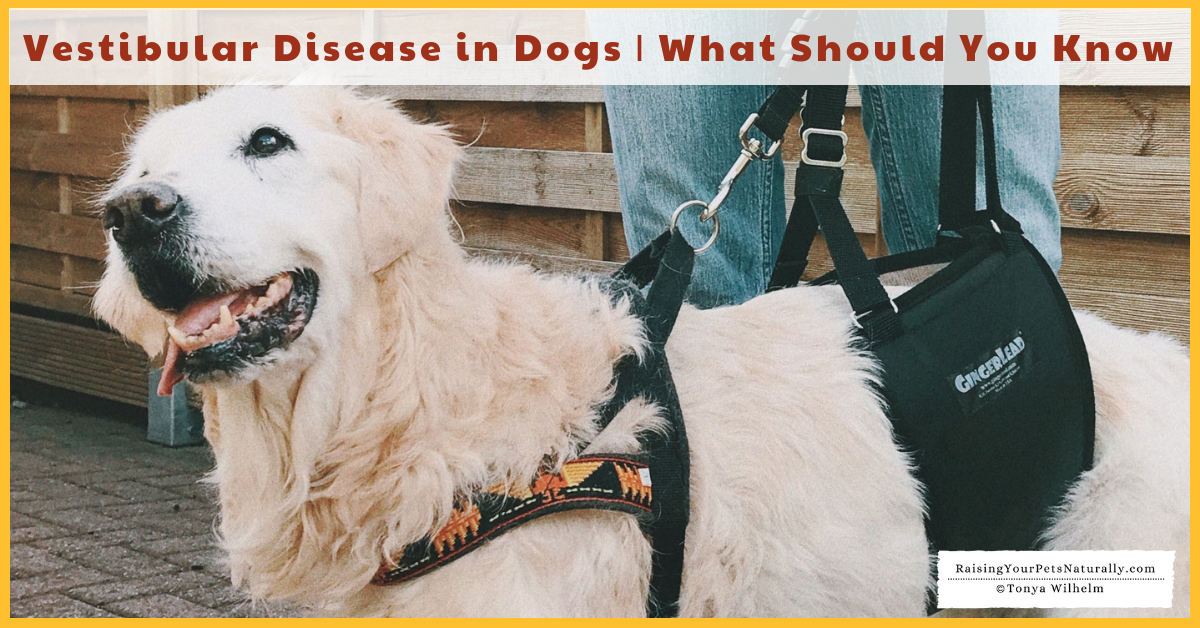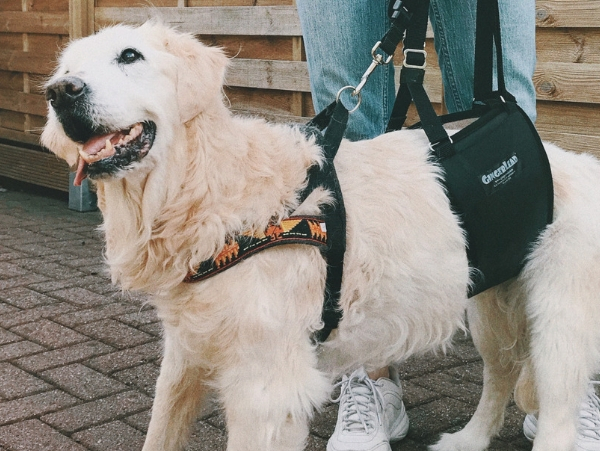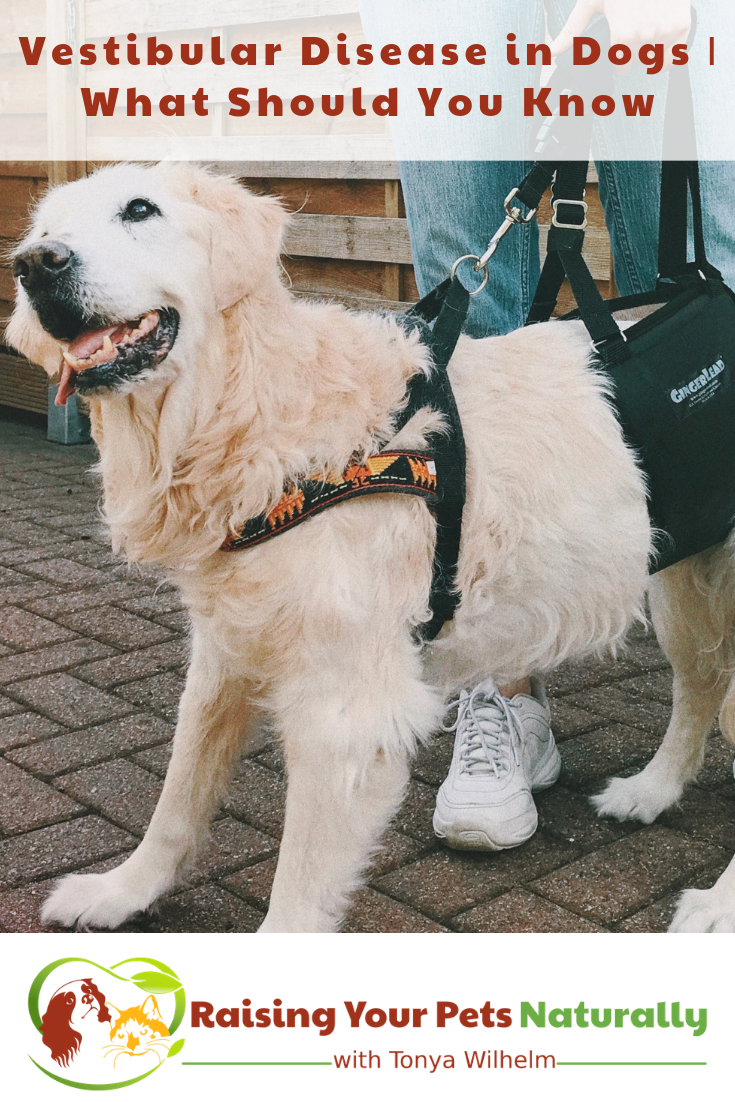Vestibular Disease in Dogs Treatment, and Vestibular Disease in Dogs Symptoms

Disclaimer: This is a sponsored post and also has affiliate links. However, I will always try to offer my readers great product selections. Your trust is very appreciated, and never taken for granted. ~Tonya, Dexter and Angel Nutter
As you may recall, Dexter is an almost 10-year old Cavalier King Charles Spaniel with Chiari Malformation and Syringomyelia. His disease affects his mobility and balance. Researching his condition and symptoms also led me down the path to learning more about canine idiopathic vestibular disease, sometimes called “old dog disease.” I spoke with one of Dexter’s holistic veterinarians, Dr. Mary L. Cardeccia. Dr. Cardeccia focuses on animal rehabilitation and natural healing methods including acupuncture, food therapy, chiropractic, Reiki, and herbology.
What is Vestibular Disease in Dogs?
A dog’s (any mammal’s) vestibular system controls the body’s balance and eye movement. The vestibular system includes the parts of the inner ear and brain that control your dog’s balance and eye coordination¹. Dr. Cardeccia stated that some of the symptoms a dog may exhibit include one or more of the following: “sudden or acute onset of loss of balance or general coordination, disorientation, inability to assess speed of movement, staggering walk, stumbling or falling, walking in circles, head tilt, rapid eye movements (called nystagmus), drooling, loss of appetite, nausea, or vomiting.”
This can be very scary for both the dog parent and the dog. It’s important to not panic and to try not to stress out your dog during an episode. If your dog is experiencing any of these symptoms for the first time, speak calmly to him and ensure his safety by preventing a slip, fall, or head injury. I would suggest getting into your dog’s vet office right away, or the emergency clinic. Although vestibular disease is not life-threatening, your dog may be having a stroke.

How to Diagnose Vestibular Disease in Pets
Obtaining a proper diagnosis is always the first step with any successful treatment plan. Dr. Cardeccia explained to me the typical diagnosis protocol. “Diagnosis is made with a thorough physical and neurological examination to determine if the symptoms are due to central or peripheral vestibular disease, or to another process affecting the balance center, such as a stroke or a tumor. In the case of peripheral disease (which is the much more common type) an otoscopic examination would also be performed, to assess the health of the ear canal, eardrum, etc. Radiographs (x-rays) or blood tests may also be indicated to rule out certain specific causes of symptoms. Biopsy of a tumor or polyp may be indicated. For central vestibular disease, an MRI or CT scan, and/or a spinal fluid tap may be recommended.”
Treatment Options for Vestibular Disease
After your dog’s diagnosis, what can you do to treat vestibular disease and help make your dog’s life as enjoyable as possible? Dr. Cardeccia has been treating Dexter’s Chiari Malformation since 2012, and he has had great improvement over the years. I was really looking forward to hearing what she had to say about treating dogs with vestibular disease.
Dr. Cardeccia explains some common therapies and treatment options. “In geriatric dogs, ‘Old Dog Vestibular Syndrome’ the condition usually resolves in one to two weeks, though the tendency to tilt the head can remain for a lifetime. If a middle or inner ear infection is present, sometimes antibiotics will be needed to improve the condition. If an underactive thyroid is the cause, the vestibular disease will often resolve when the metabolic condition is managed correctly. Dizziness can prevent dogs from walking at all, or from walking properly, so keeping food and water nearby or assisting with eating and drinking may initially be necessary. Nausea and vomiting can be managed with anti-emetic (anti-nausea) medications, and there are medications that will help with the vertigo (dizziness) also, which are the same medications that are used to treat motion sickness.”
She continued by saying, “If there is an underlying infection, it should obviously be addressed with the appropriate antibiotic. If the symptoms were caused by a medication, removal of the medication should result in improvement, but often there may be a little residual hearing loss. Removal of polyps or tumors may be indicated, and must be assessed on an individual basis.”
“Central vestibular disease usually has a much poorer prognosis, as it may be a result of a stroke (cerebrovascular disease), tumor, infection, inflammatory disease, or medication reaction. Treatment would be very specific based on the underlying cause. Fortunately, the most common form of canine vestibular disease – the peripheral form – in most cases improves quickly, once the underlying cause is addressed and symptoms of vertigo are managed with supportive care.”
Support Devices for Dogs with Vestibular Disease
If your dog has vestibular disease or any other mobility issue that makes it hard for your dog to get up, down, or walk, GingerLead Dog Support and Rehabilitation Harness is a great option. GingerLead is a padded support sling and a great aid for older dogs with vestibular disease that struggle with their balance and mobility. Using it provides your dog with much needed support and stability while cradling their belly in comfort, making it significantly easier for them to walk and increasing confidence by keeping them from falling down. With vestibular disease, attach the GingerLead’s leash to a chest harness to provide additional support of their front end.
Fina’s video.
Quote from Fina’s mom, “With the GINGERLEAD Harness, Fina’s life got much easier. She’s a 16-year-old Golden Retriever lady. Her spirit is invincible. Her body, sadly not. The last few years, she had to deal with several epileptic seizures and the vestibular disease, but she’s still standing. And now stronger than ever.”
Dexter and I reviewed GingerLead in 2017, and I still stand behind the product. Dexter hasn’t had to use it yet, but I have it when the time comes. Unfortunately, with his neurological condition, that time will likely come. Knowing we have the GingerLead brings me peace of mind.
Reasons for Vestibular Disease in Dogs
I’m always a why kind of gal. I want to know why something happens so that I can hopefully prevent it from happening in the future. Is vestibular disease preventable? Are there things that a dog parent might accidentally be doing to increase a dog’s chance of getting vestibular disease?
Dr. Cardeccia tackles my questions. “There is a peripheral form of the disease arising from outside the central nervous system which is caused by disorders affecting the inner ear. Peripheral vestibular disease occurs when there is irritation to the nerves connecting the inner ear with the brain. The result is a loss of balance and other symptoms resulting from vertigo and dizziness. This may be a result of chronic and recurrent inner and middle ear infections, overzealous cleaning of the ears resulting in a perforated eardrum, trauma from head injury, tumors, polyps, meningoencephalitis, or hypothyroidism, as well as certain drugs.”
Already, from her response, I know there are a few things that a dog owner can do to help decrease the chance of their dog getting peripheral vestibular disease. If a dog is on a healthy, fresh-food diet, they are more likely to have clean ears and not need their ears cleaned. If a dog does need an ear cleaning, be gentle and don’t go down to the eardrum. Second, watch those drugs and chemicals you are giving or putting on your dog. Try to stay as natural as you can and use medications sparingly when possible.
Dr. Cardeccia continued by saying, “There are also many cases which we call ‘idiopathic,’ meaning that we can’t identify an underlying cause for the symptoms, although we can localize them to the inner ear/vestibular system. This is what is usually meant when we use the term “Old Dog Vestibular Syndrome.” Central vestibular disease, which is a much less common and more serious form of the condition, originates inside the central nervous system. Central disease may be the result of stroke, tumors, polyps, infection/inflammatory disease, or medication reaction.”
I was curious to know if certain breeds were more prone to vestibular disease. Here is what she had to say. “There is also a congenital form of the disease which is usually seen between birth and three months of age. Breeds of dog predisposed to this condition include the German Shepherd, Doberman Pinscher, English Cocker Spaniel, Beagle, and possibly Akita, Smooth Fox Terrier, and the Tibetan Terrier. Breeds of cat predisposed include Siamese, Burmese, and Tonkinese.”
Of course, I had to look up the Cavalier King Charles Spaniel, since that is Dexter’s breed. Obviously, any breed can have vestibular disease, and the Cavalier is prone to a few other diseases that may present similarly to vestibular disease. Primary secretory otitis media (PSOM), cerebellar infarcts, or strokes and, of course, Chiari Malformation and Syringomyelia are three other diseases that may look like vestibular disease. This is why, a good veterinarian team is crucial.
If your dog develops vestibular disease or any other condition, try not to let his diagnosis get you down. It’s important to LIVE each day to the fullest and look for ways to help your dog have a good quality of life. Luckily, there are a lot of natural treatments, physical therapy options, and products such as the GingerLead that can greatly improve your dog’s quality of life. Be your dog’s voice and find answers; he deserves it.
1 https://vestibular.org/
Your comments and questions are welcome.
Are you looking for even more ways to stay up to date with Raising Your Pets Naturally? Sign up for the newsletter for more tips and promotions. Don’t forget to be social and Like, Follow and Subscribe.
Facebook Twitter Pinterest Instagram YouTube
 |
 |

Google Adsense—>






This has been a very interesting read, very well documented and written. I worked for an online pet shop for a few years (as a computer programmer) and I learned a lot about dogs and their health but I still learned new things from your post, so thanks you
Thank, you! I really appreciate that, Raluca.
This is such a great post. It has so much information! I have a friend whose German Shephard came down with vestibular disease, and it was hard on him.
Thank, you, Stacie. Awe, poor kid. <3
I didn’t know this disorder that some dogs may have, the important thing is to love them anyway.
Agree. And to be able to provide them with a high-quality way of life.
Such an informative read! I always get so sad when dogs are visibly in poor health and I think it is so important to fully understand what is happening and why it’s happening when it comes to pet health! Thank you for sharing!
Thank you. <3
This is very useful information for every dog owner. It’s important to pay attention to your pet and take him to the vet if you notice that something is not right.
Thanks, Joanna!
This is some valuable information for dog owners. I feel like I learned a lot from reading your post!
Thank you! I try to interview great people.
I adopted a 10-year-old dog several years ago. From the moment we got him, he was very slow and never had a ton of energy. The vet always said he was fine, but we always felt he maybe had an underlying issue. When we moved to Colorado, I don’t know if it was the change in altitude, but he deteriorated very quickly. Some of the symptoms of this disease sound very familiar. Unfortunately, we will never know what was wrong with him. We still have our other dog, and we try our best to feed him well and get plenty of exercise. This is really great info for dog owners.
Thank you, Emmy for your post. I am so sorry to hear about your other boy. <3 Hugs.
This is very useful information. I didn’t know much about vestibular disease at all.
Thank you. So glad to share this important topic.
Thanks for this informative post. We have been wanting to get a dog for a while now and this info is important.
Thank, you! Good luck with your new dog. It’s such a fun adventure.
Very informative piece. When I was a kid I remember having old dogs who had similar symptoms like this. I never knew until today. I now owned a healthy loving doxie and will forever keep this advice in mind. Taking down notes for sure!
Thanks, Joyce. Oh, doxie love. You might want a GinderLead on hand for those possible back issues.
I never heard of this Vestibular disease in dogs until I read this. Thank you for sharing such an information. Glad there was support made for them.
Thank you. The GingerLead Support Harness is such a great way to help these dogs and other dogs with mobility issues. I love what they are doing for the dog community.
Such an informative post about this disease. My friend does have a dog with vestibular and I can see in their eyes how hard it is.
<3 Thank you. I hope your friend finds this post helpful. Hugs to your friend.
Very informative. My neighbor’s old dog had this and it was so difficult to handle though there are ways to help. Thanks for sharing!
Thank you. Glad to share.
What a thorough and informative post about vestibular disease in dogs – I had never actually heard of it before! My cat is getting up there in years and has had several health issues that require special attention like his asthma and dental problems that resulted in us having to remove all but one of his teeth. He’s still the sweetest, most loving kitty and is worth all the extra care <3
Thanks, Amanda. Cats also can get vestibular disease. Hugs to your kitty.
i never heard of old dog disease. It actually breaks my heart to read this.
<3 We all get old and our bodies do start to deteriorate. Luckily, there are things we can do, products we can us for ourselves and our pets to make the process easier.
Thanks for sharing your tips on ways to treat vestibular disease in dogs. Indeed it will be super useful for the pet owners.
<3 Thank you!
Thank you for sharing that information and for letting us know what is a vestibular disease. Dogs are like human too. We should love them and treat them like a part of the family.
Sure thing. I totally agree. They deserve the best.